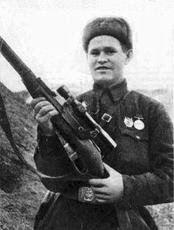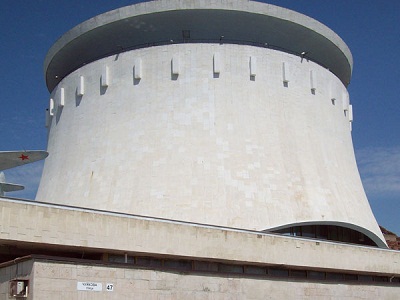Zaitsev, Vasily G.
Vasily Grigoryevich Zaytsev was a Soviet lieutenant who became well known for his role as a sniper during the battle for Stalingrad. The legend goes that Zaytsev fought a German "supersniper" in Stalingrad and managed to shoot him after a duel that lasted for days. Although many people claim the duel has taken place, there is no proof that the German supersniper existed or that a duel between the two has ever taken place in Stalingrad. It is said his opponent was Erwin König or Heinz Thorwald, but no German officers were ever found under this name. This is illogical, especially because this was supposed to be a high-ranking officer. There were no sniper training facilities in Zossen, Germany, either. In addition, if Zaytsev really did kill such an important sniper, Soviet propaganda would have gladly used this victorious event. Moreover, although each detail of the alleged showdown between the two snipers was tastefully packaged and reported to Moscow, there is no proof of this duel there, either. Indeed, it is the book "War of the Rats" by David L. Robbins and the host of liberties taken in the 2001 film "Enemy at the Gates" that spread this legend around the world.
Vasily Grigoryevich Zaytsev was born on 23 March 1915 in Yelino, a village at the foot of the Ural mountain range, to a family of farmers. He spent his summers working there as a shepherd. He was barely four years old when he started hunting squirrels with bow and arrow and by the time he turned 12, he advanced to hunting stags in the nearby forest with his grandfather. This is where he developed a taste for sniping. When he turned 15, Zaytsev enrolled at the technical school in Magnitogorsk where he trained as an accountant.
In 1936, Zaytsev entered service in the Red Navy. After serving as a sailor for five years, he enrolled at the School of Military Administration, which he successfully completed, and then led a financial section of the Pacific fleet as a non-commissioned officer. After repeated requests, he was transferred to the Stalingrad front. On 20 September 1942, 27-year-old Zaytsev was drafted into the 1047th Assault regiment of the Siberian 284th Assault division and crossed the river Volga. But, he did not get his sniping rifle yet. Zaytsev claimed that in October he shot a German soldier from a large distance and that his commander confirmed the killing. This earned him his first sniping rifle, a Mosin-Nagant M-1891/1930. At that time, Zaytsev was one of only a few snipers in Stalingrad and was soon commissioned to set up a sniper school. However, he was still a student himself. Later he said that he "learned from his own mistakes." Zaytsev, which means hare in Russian, had trained 30 other Soviet soldiers as snipers. They became known as zaytsy, the hares.
Zaytsev became famous after he killed almost 40 enemies in ten days. The war correspondents marveled at his surprising ability to kill with a single bullet. When he approached 100 killings, the Soviet propaganda started presenting Zaytsev as the poster child of the Soviet resistance.
The legend goes that the German supersniper, Major Erwin König or SS-Standartenführer Heinz Thorwald, the head of the German sniping school in Zossen, Germany, had arrived in Stalingrad. His only task was to eliminate Zaytsev. He studied Zaytsev’s techniques as they had been extensively described in Soviet propaganda pamphlets. Soon after his arrival, two Soviet snipers were killed by a German sniper very shortly one after the other. Zaytsev knew that the German sniper he was looking for had to be behind this. Together with a colleague, Nikolai Kulikov, and a political officer, a man called Danilov, Zaytsev waited for any sign of the German. Suddenly, Danilov stood up from his hide: he saw the German sniper and wanted to point his position to Zaytsev. Danilov was killed immediately. Zaytsev saw the flash from the German’s rifle and located him: under an iron sheet with a pile of stones beside it. Slowly, Kulikov lifted his helmet a bit, but as he did, the German shot a hole in his helmet. Kulikov pretended to perish in agony. The German thought that he had killed Zaytsev and came up a bit from his hide. Zaytsev shot him.
In October, Zaytsev had 100 confirmed killings. He was awarded the Order of Lenin. Most sources claim that Zaytsev shot 257 enemies between 20 September and 17 December 1942, including 11 snipers. Zaytsev shot 32 enemies with an ordinary gun. However, the total number of his confirmed killings during the war is unknown. The estimates vary between 149 and 400.
In January 1943, Zaytsev got injured by the blast of a landmine in Stalingrad and was temporarily blinded. After he recovered, Zaytsev returned to the front. On 22 February 1943, Zaytsev was awarded the title Hero of the Soviet Union. In the later stages of the war he was promoted to First Lieutenant and then to Captain. Zaytsev was awarded the Order of the Patriotic War 1st Class, the Order of the Red Banner twice, and several other decorations.
After the war, Zaytsev married and settled in Kiev where he became a director of a machine factory. On 7 May 1980, he became Honorary Citizen of the Hero City of Volgograd. He also published his memoirs, "Zapiski snaipera," translated into English as "Notes of a Sniper - For us there was no Land beyond the Volga."
Vasily Zaytsev died at the age of 76 on 15 December 1991 in Kiev. On 31 January 2006, his remains were transferred to Mamayev Kurgan in Volgograd because that had been his dying wish. The Panorama museum of the battle for Stalingrad in Volgograd has Zaytsev’s rifle on display, as well as a telescopic sight which allegedly belonged to his German opponent.
Definitielijst
- propaganda
- Often misleading information used to gain support among supporters or to gain support. Often used to accomplish ideas and political goals.
- regiment
- Part of a division. A division divided into a number of regiments. In the army traditionally the name of the major organised unit of one type of weapon.
- resistance
- Resistance against the enemy. Often also with armed resources.
- sniper
- Military sniper who can eliminate individual targets at long distances (up to about 800 meters).
- Soviet Union
- Soviet Russia, alternative name for the USSR.
Information
- Article by:
- Auke de Vlieger
- Translated by:
- Besmir Fidahic
- Published on:
- 19-01-2025
- Feedback?
- Send it!

















